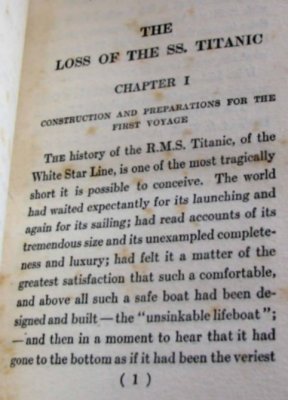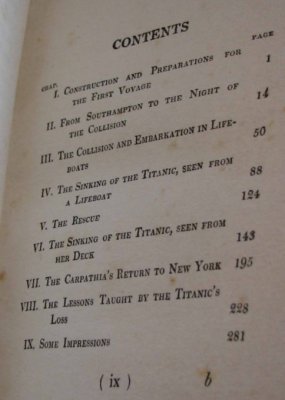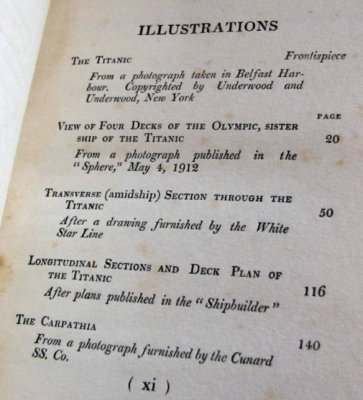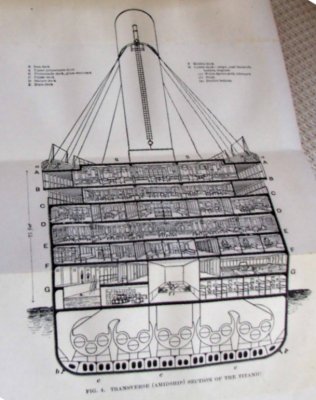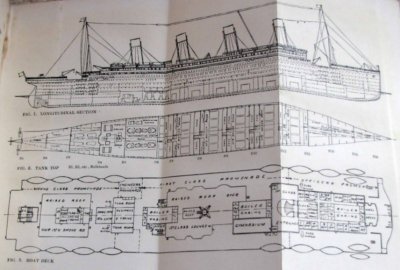Lawrence Beesley taken about 1911
 Lawrence Beesley, schoolmaster.
Lawrence Beesley, schoolmaster.
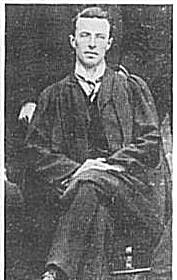 Lawrence Beesley's book
Lawrence Beesley's book

Lawrence Beesley & the Titanic
Lawrence Beesley is best known for surviving the sinking of the Titanic
in 1912, and writing one of the first books on the tragedy, called
"Loss of the SS Titanic, Its Story and Its Lessons"
He was born in 1877, taught Science at Anthony Gell School, Wirksworth 1902-1904,
and died in 1967.
Stuart Flint sent the following information about his connections with
Lawrence Beesley, thanks Stuart.
A great deal can be found about Lawrence Beesley by searching Google
on the following keywords: "Lawrence Beesley", Titanic, Wirksworth.
He was born in 1877, taught Science at Anthony Gell School, Wirksworth 1902-1904, and died in 1967.
Stuart Flint sent the following information about his connections with Lawrence Beesley, thanks Stuart.
A great deal can be found about Lawrence Beesley by searching Google on the following keywords: "Lawrence Beesley", Titanic, Wirksworth.
From: STUART FLINT
Hello
You may be interested in the following information
Lawrence Beesley who was a survivor of the Titanic disaster April 1912 was
son of Henry Beesley of Heysham Lancs (born 1845) who at age 12 years
lived with his Uncle and Aunt Samuel and Anne Flint nee Taylor..
at Steeplegrange near Wirksworth
Henry by age 18 was a Solicitors Clerk along with Andrew Macbeth and
John James.. at either Hodgkinsons or Hubbersty's Solicitors at the
office now Andrew Macbeth Cash & Co recently taken over by Potter & Co
Matlock.. but, by his marriage to Anne Marie James sister of the
aforesaid John James, they the children of Thomas James Glassware
Dealer St John Street originally from Pembroke South Wales..
Henry was a Bank Clerk at Capital & Counties Bank Bank Terrace
(The Causeway, now Lloyds T.S.B. rebuilt after Arkwright & Toplis days
in 1861 then owned by Maltby & Robinson also known as Nottingham Banking
Co.. by my Grt Grandfather Joseph Walker & Sons who also built
Compton & Evans, now NatWest Market Place Wirksworth and many of
the shops on St John Street plus The Baptist Church Coldwell Street
and Mount Zion Methodist Church Middleton plus Railway Contracts) ..
Henry by 1895 was Bank Manager at Capital & Counties Bank then removing
to their larger Branch at Corporation Street Manchester.. his wife
Anne Marie and children remaining at the Bank House Bank Terrace up
to all removing to Manchester.
Henry Beesley was nephew to Samuel and Anne Flint nee Taylor of
Steeplegrange. Samuel a Mining Agent son of Samuel and Hannah Flint
nee Allen of Bolehill they my 4XUncle and Aunt.. Samuel senior
Mining Agent at The Dovegange and Rantnatakers Lead Mines twixt
Black Rocks and Middleton..his brother Joseph Mining Agent at The
Bage and Ratchwood Lead Mines Bolehill and Rise End Middleton respectively
Lawrence Beesley married Gertrude Cecile Macbeth daughter of Thomas
Alexander Macbeth of Manchester he son of Andrew Macbeth and Isobella
nee Spencer she daughter of Anthony and Ellen Spencer of Gorsey Bank
Wirksworth ..Spencer's both my wife and my own family.. Andrew Macbeths
brother Isaac was father to Andrew Macbeth who founded the solicitors at
Wirksworth.. Isaac and Andrew seniors Grand fore bare was Isaac Hoades
my 5XGrandfather who married Anne Shaw 1st wife and my true Grt Grandmother..
Anne of the Shaw family who opened up Middle Peak Quarry(eventually known as
Bowne & Shaw) and other workings on Colehills and at Matlock Dale.. When
Anne died Isaac married Elizabeth Peach they Grand fore bares to Isaac
and Andrew Macbeth seniors Isaac a Baker on St Mary's Gate Wirksworth
followed on as bakers by Baggaleys who married into Shaws then Halls
(Luke of Bolehill) of my allied kin and then Addy (Adam) Killer of my
kinship.. still owned today by a distant kinsman of my wife and my
Slack family re Taylors of Middleton / Bolehill
Lawrence Beesley born 1877 as you will know was, for a time, a school
teacher (Science) at Anthony Gell School 1902 - 1904 then a lecturer at
Dulwich College..Gertrude died by 1911 after having one son Alec and so
Lawrence booked a 2nd class ticket on the new ship Titanic to visit Canada
to see his brother Frank Meredith Beelsey then in his mid 20s ...
The rest is well recorded history so I will not bore you with the detail..
Alec Beesley son of Lawrence, married, after a long and rather tedious
courtship, to Dodie Smith they both struggling actors at Manchester
(The Athenian owned by Dodies Uncle)
Alec was a Pacifist and just before the 2nd war broke out to avoid call up
he and Dodie emigrated to America where Dodie began to make a name for
herself as an author, who wrote books ie 101 Dalmatians and other works
which have been made into films (101 Dalmatians presently being produced
at The Theatre Royal Nottingham with all star castings). Dodie Smith died
at Manchester in 1990 in her 90s. Lawrence married again to "Mollie"
Greenwood..and had children Laurien Hugh and Waveney.. I am presently
gaining contact to Nicholas Wade the son of Laurien Beesley (married
Michael Wade) by Mr Pat Cook who I have contacted giving more information
re Beesley's Mr Cook a co writer re Encylopaedia Titanica..and Phillip
Beesley of Toronto Canada heir of Frank Meredith Beesley brother to
Lawrence..the brother Lawrence was intending to visit via his Titanic journey
Lawrence Beesley obt 1967 London
Regards Stuart G Flint
Subject: Beesley
Date: Mon, 24 Jul 2006 11:14:16 +0100 (BST)
To: 
Dates:
Photo taken:
Size:
Source: Click on photo for enlargement (on CD only)
Have any more information about this photo?
Please e-mail the author on:
Click on photo for enlargement (on CD only)
Have any more information about this photo?
Please e-mail the author on:

 Click on photo for enlargement (on CD only)
Have any more information about this photo?
Please e-mail the author on:
Click on photo for enlargement (on CD only)
Have any more information about this photo?
Please e-mail the author on:

